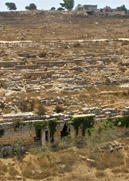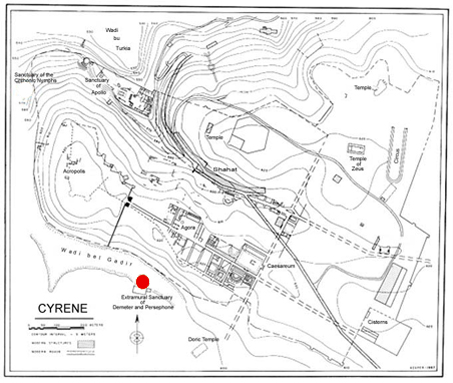
The Extramural Sanctuary of
Demeter and Persephone
Cyrenaica
Terracottas
is an interactive web site designed for
archaeologists, art historians, historians, and classicists
who have an interest in the typological diffusion of Greek
terracottas at ancient sites in Cyrenaica, Libya, as well
as elsewhere around the Greek world.
Updated August 30, 2018 |
|
The Extramural Sanctuary of Demeter and Persephone at Cyrene
For the terracottas click here
The
terracottas presented in the following pages were uncovered at the Extramural
Sanctuary of Demeter and Persephone at Cyrene,
Libya, between1969 and 1978 by the American Archaeological Mission to
Libya under the direction of Professor Donald White of the University
Museum of the University of Pennsylvania. After 2 study seasons in 1979
and 1981, political tensions between the United States and Libya were
such that the project had to be discontinued. In 2004, after an interruption
of 23 years, the Sanctuary again became the focus of study, this time
by Cyrenaica Archaeological Project (CAP), an international mission
under the direction of Professor Susan Kane of Oberlin College.
The Extramural Sanctuary of Demeter and
Persephone at Cyrene was the focus of cultic activity from the early
6th century B. C. until it
was destroyed by an earthquake in A. D. 365. One of the most important
sanctuaries of the city, it was the site of the Thesmophoria, an
annual religious festival by which the fertility of the crops, livestock,
and even of the inhabitants of the city themselves could be vouchsafed.
But it also was the center of daily religious ritual based on supplication
or thanksgiving when worshippers offered gifts to the two goddesses.
It is these religious dedications that have formed the basis of the
archaeological record that includes some 4,500 terracotta figurines.
These were found in varying concentrations throughout the Sanctuary,
where they had been moved during the many remodelings that the Sanctuary
underwent. Consequently, they are not associated with any meaningful
stratigraphy or with any one particular structure or area.
Systematic
dedications of terracottas at the Sanctuary began in the second quarter
of the 6th century with East Greek terracottas in the form of perfume
containers and their related figurines. By the late 6th century these
were accompanied at the Sanctuary by the terracottas of Athens and Corinth.
Also at this time local terracotta production began on an industrial
scale but the importation of East Greek terracottas increased by the
beginning of the 5th century B. C to overwhelm the products of any other
center. Athenian models were copied and re-interpreted throughout the
5th century, the period that saw an intensification of terracotta production
on a grand scale. By about the second quarter of the 4th century B.
C. the practice of dedicating terracotta figurines at the Sanctuary
had slackened off considerably. At this time Sicilian and south Italian
terracotta prototypes began to be influential in the local production,
but eventually mainland prototypes reflecting the Tanagra style were
prefered by local artisans. 
Plan of Cyrene with the location of the Extramural Sanctuary of Demeter and Persephone indicated in red |
|

|